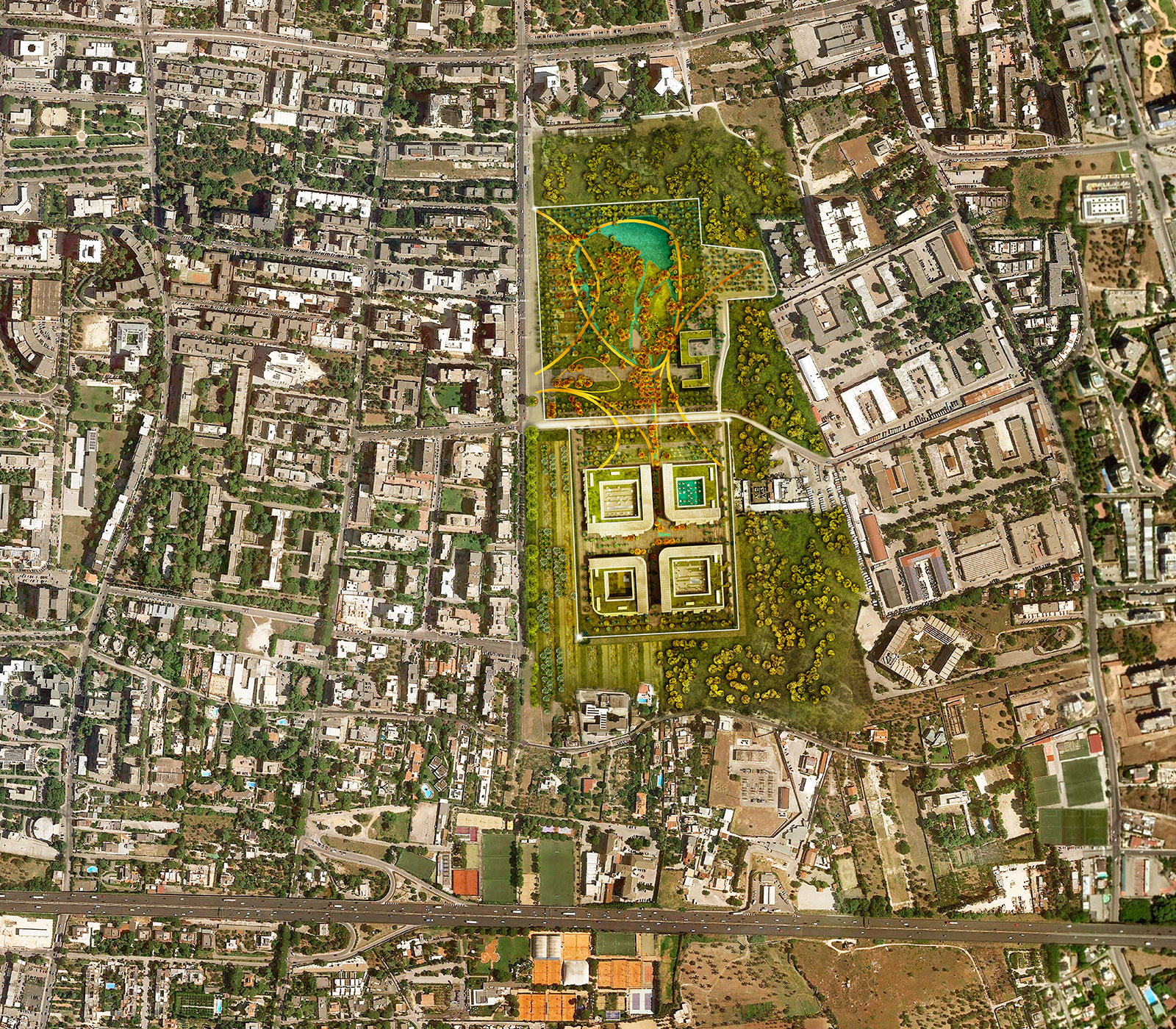
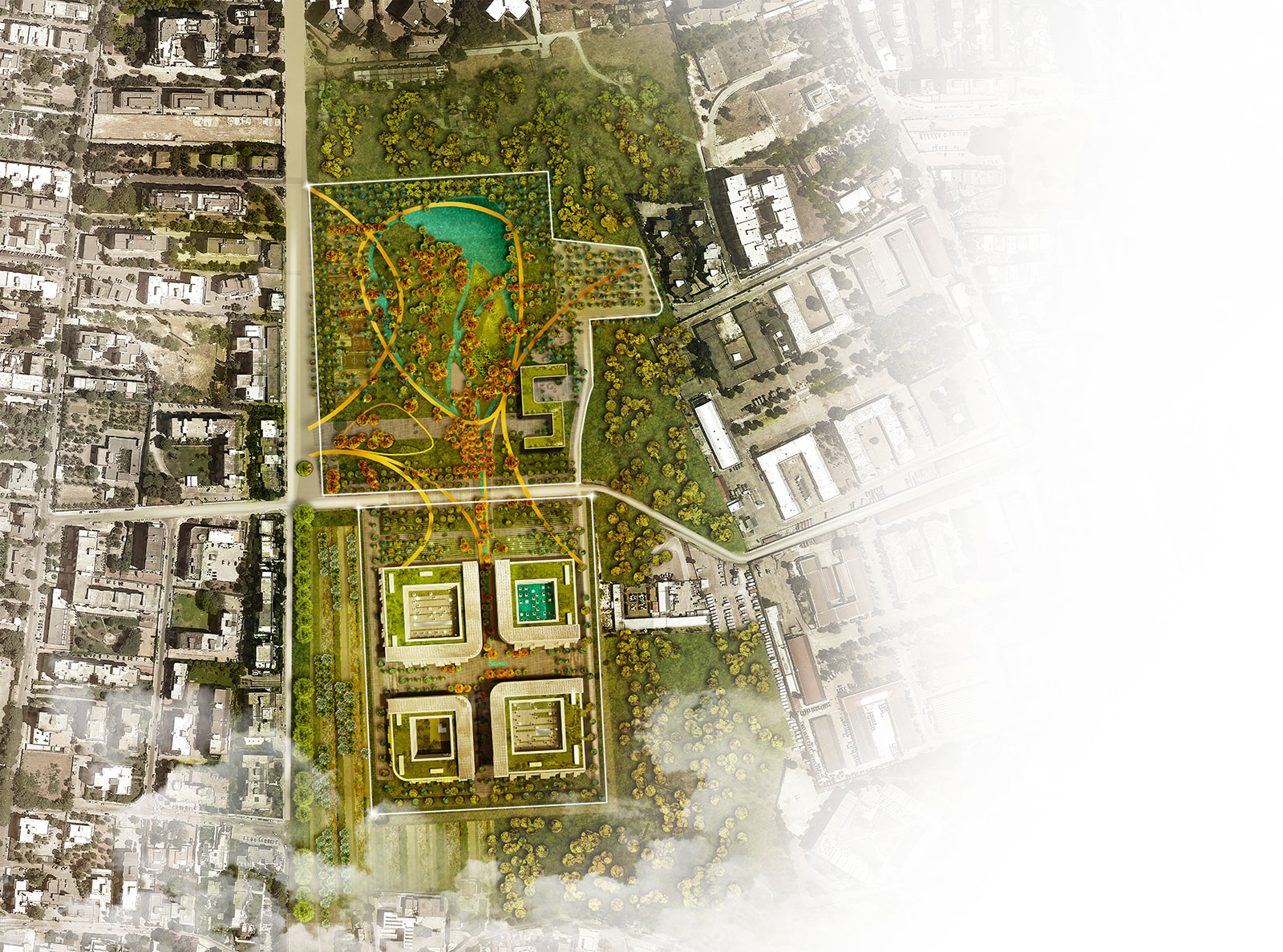
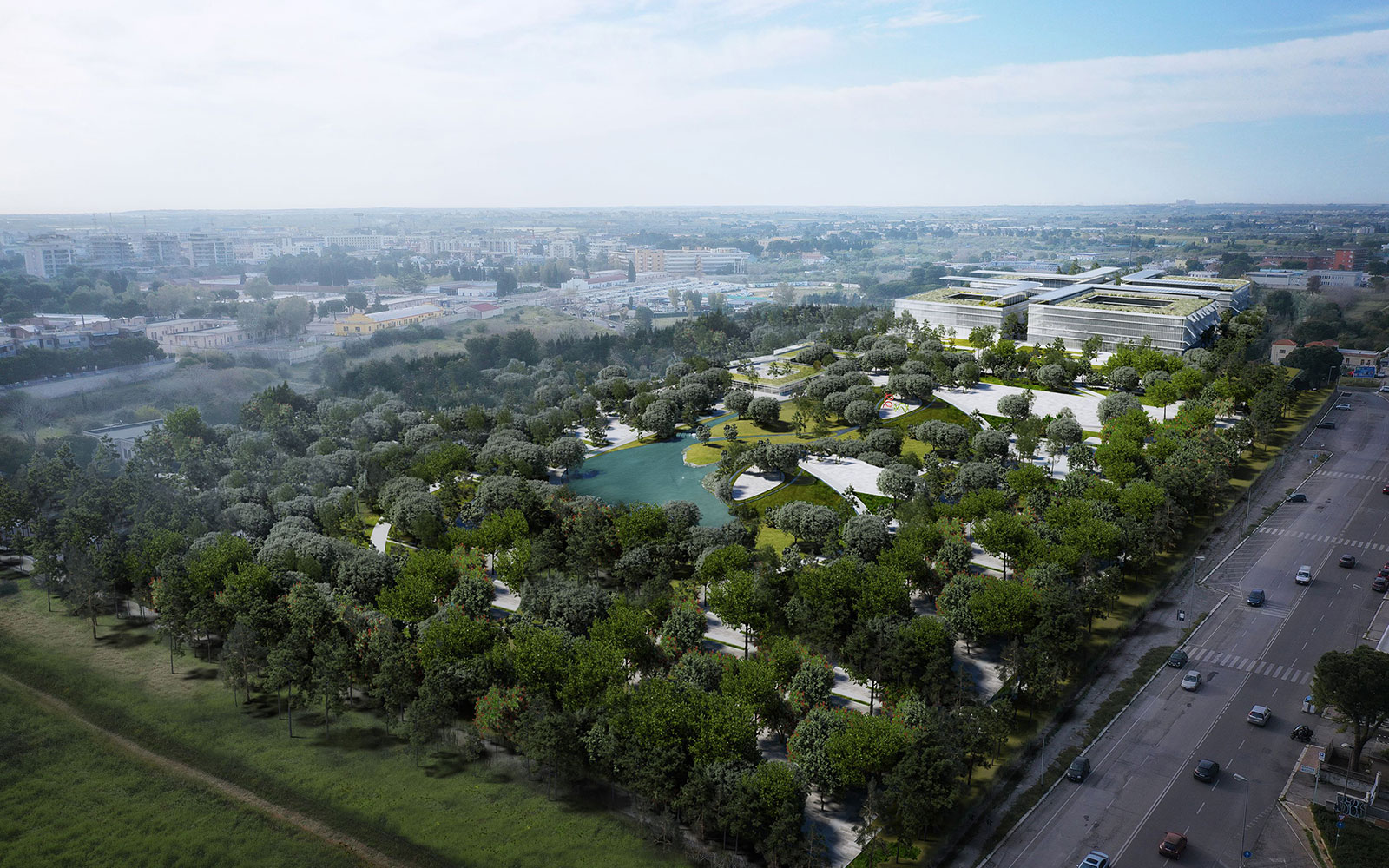
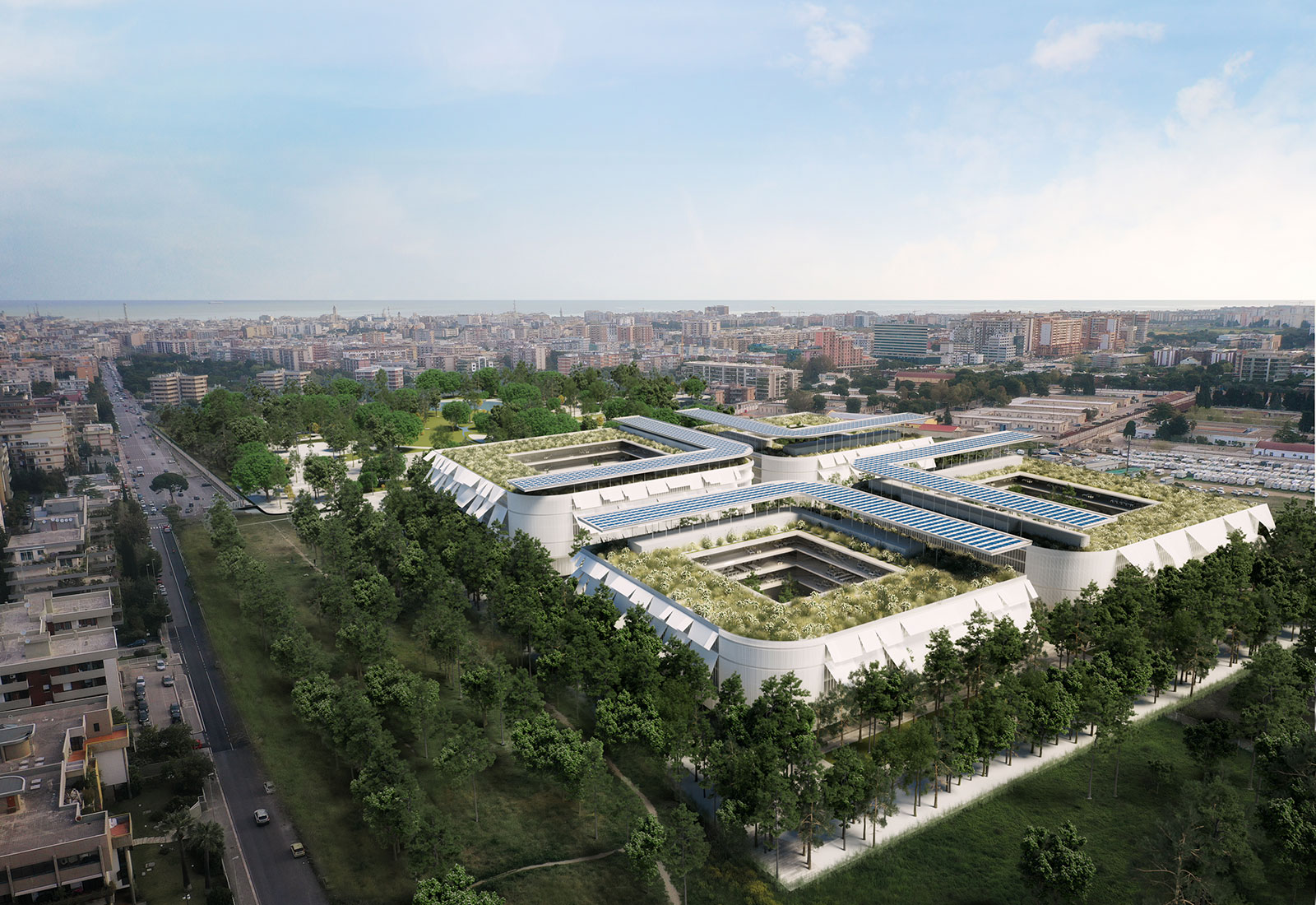
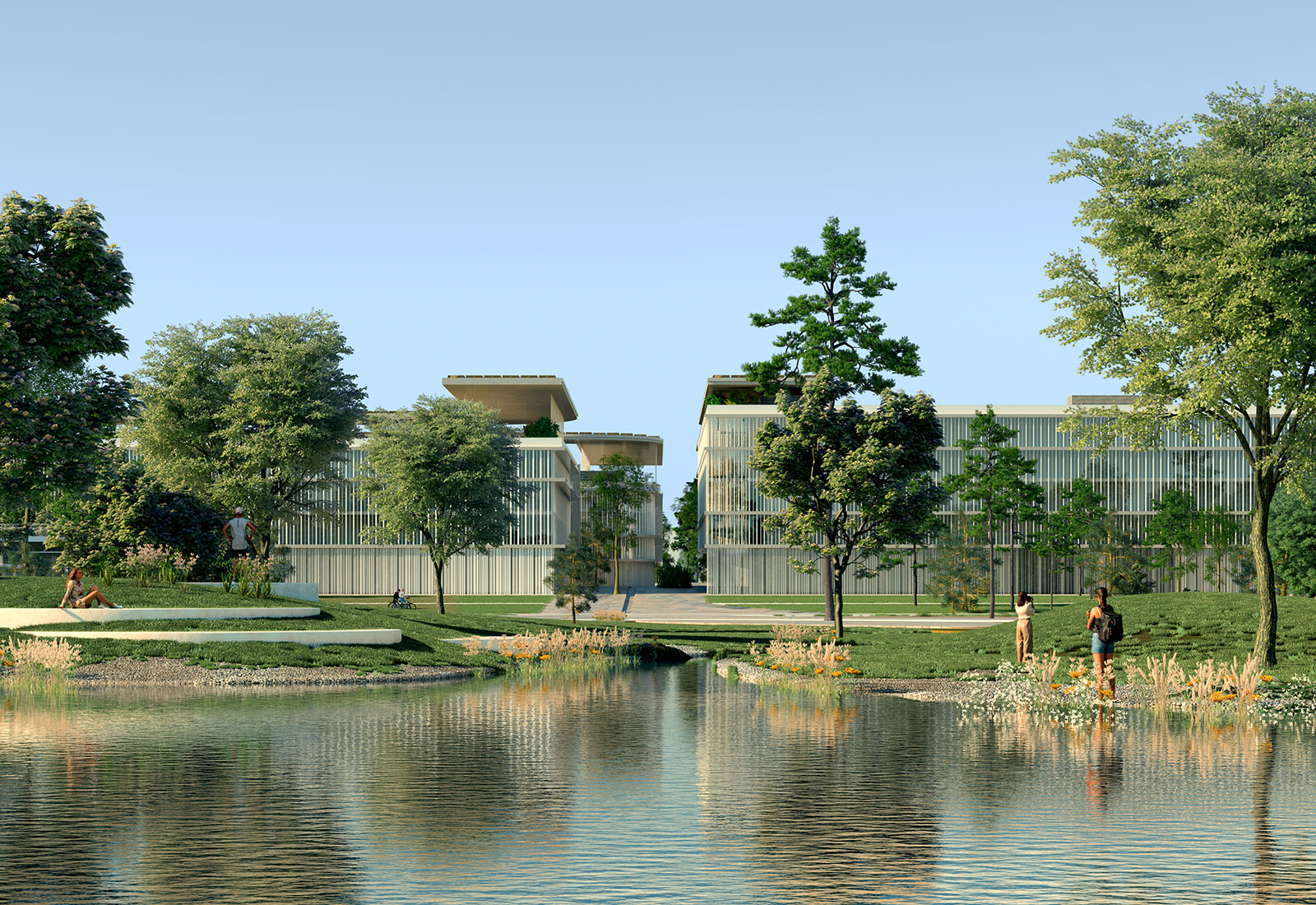
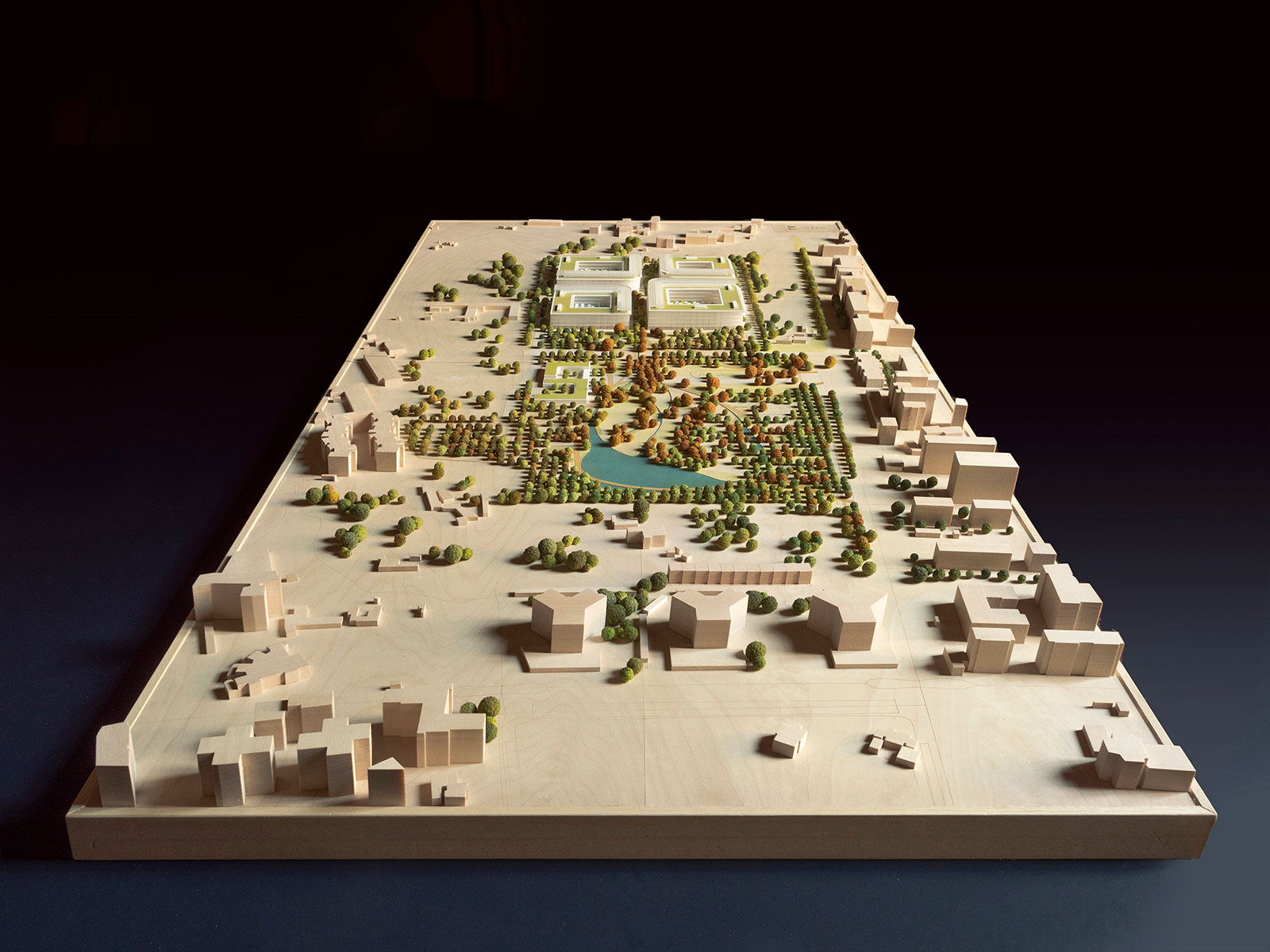
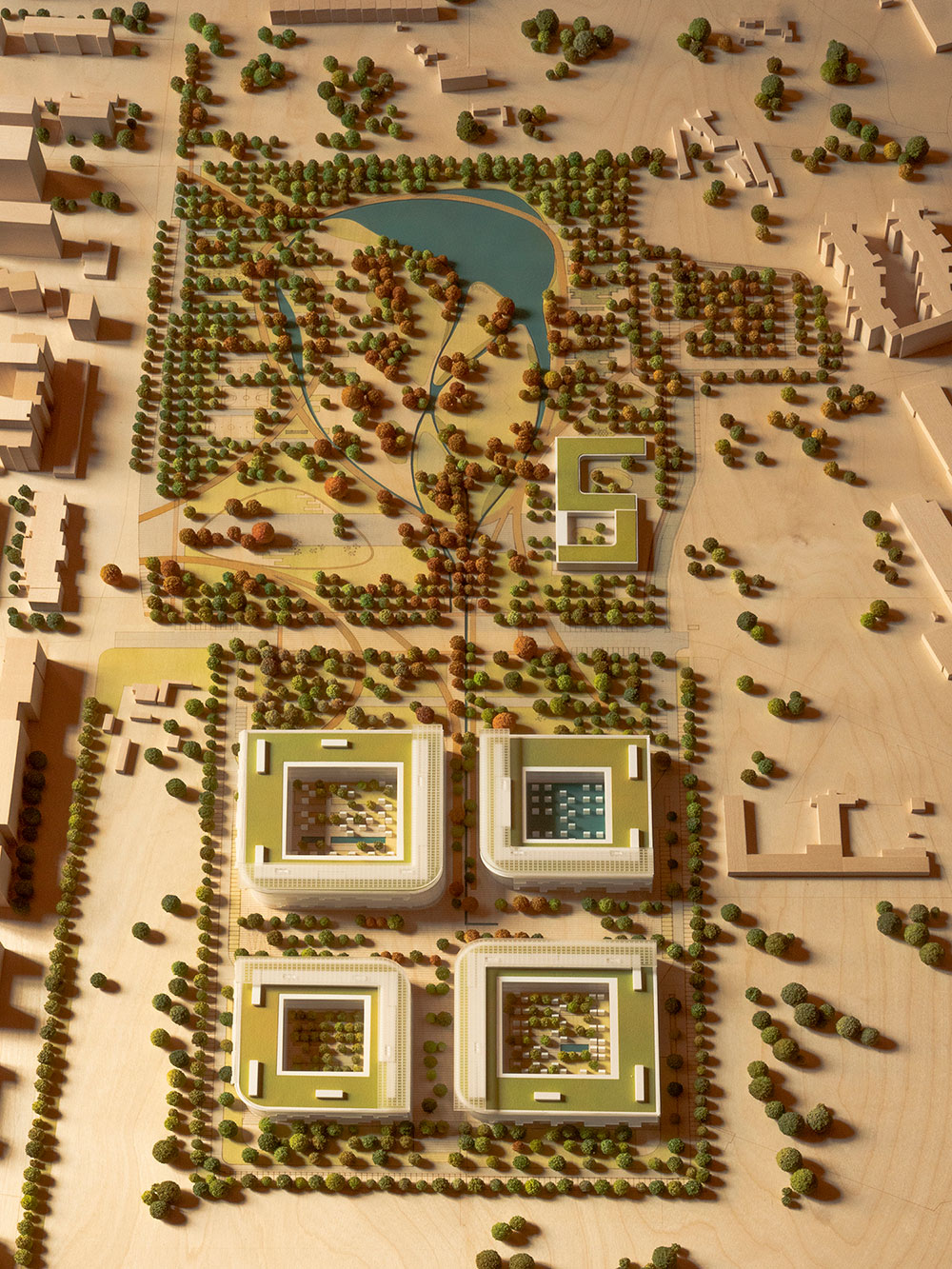
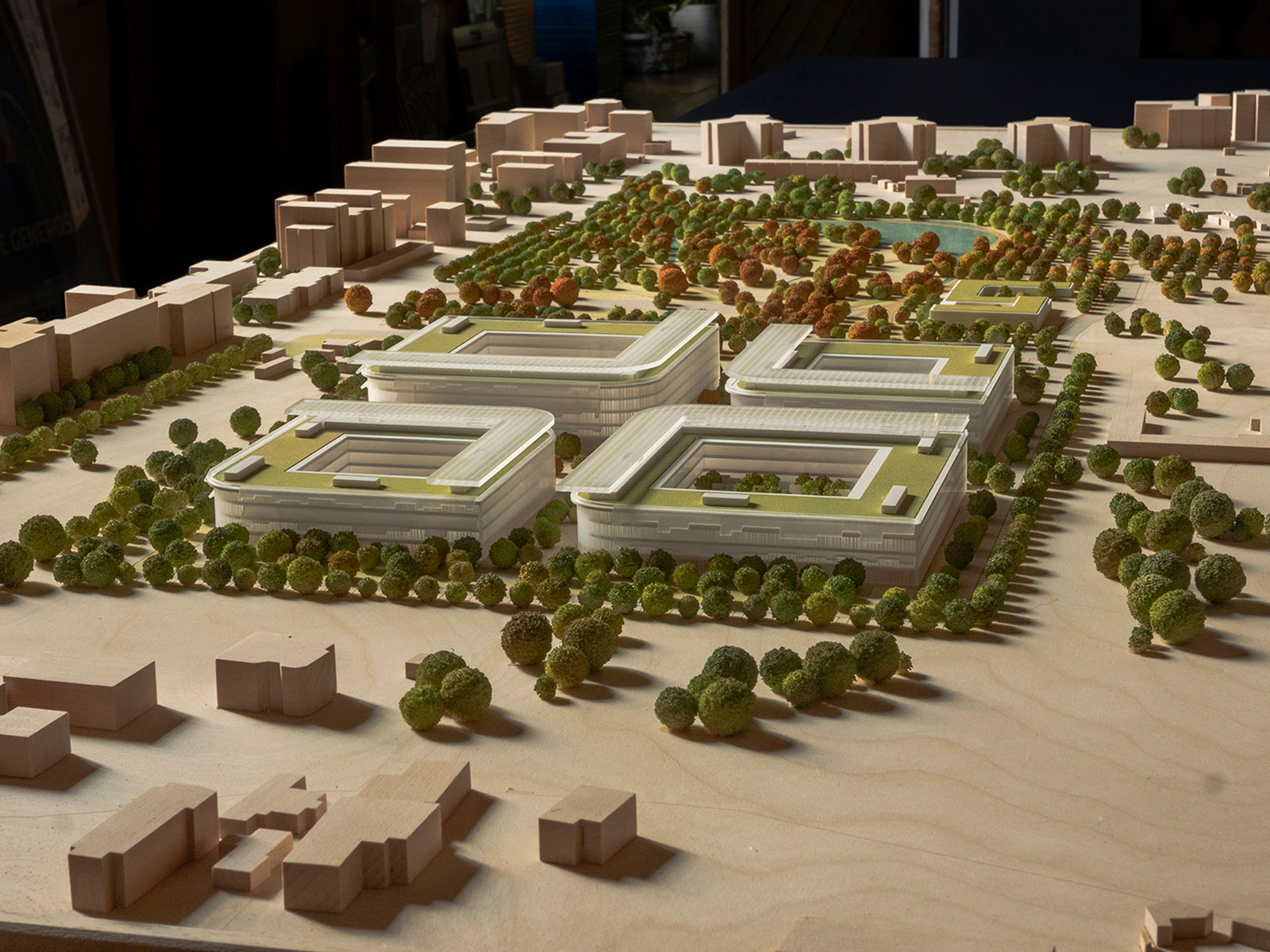
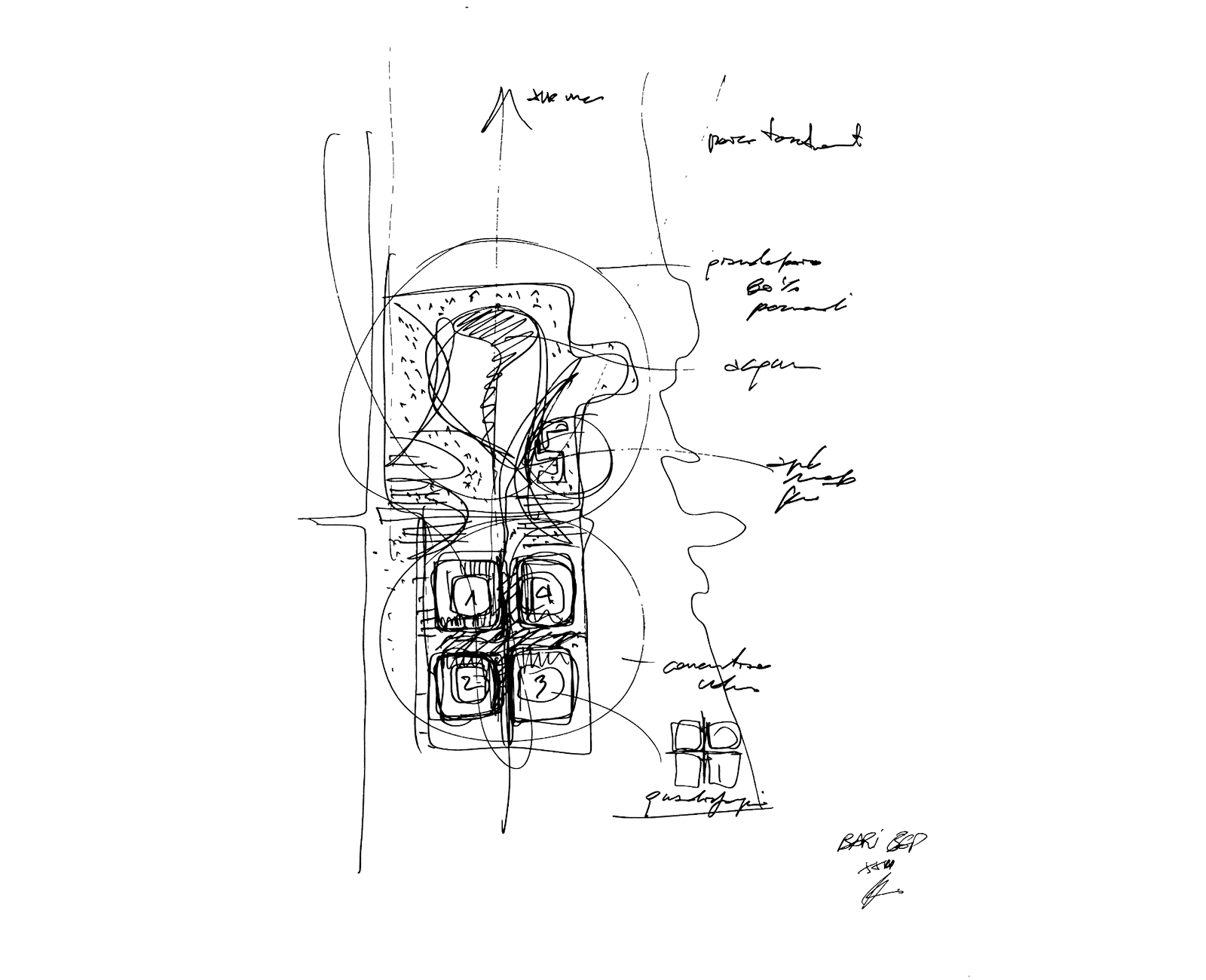
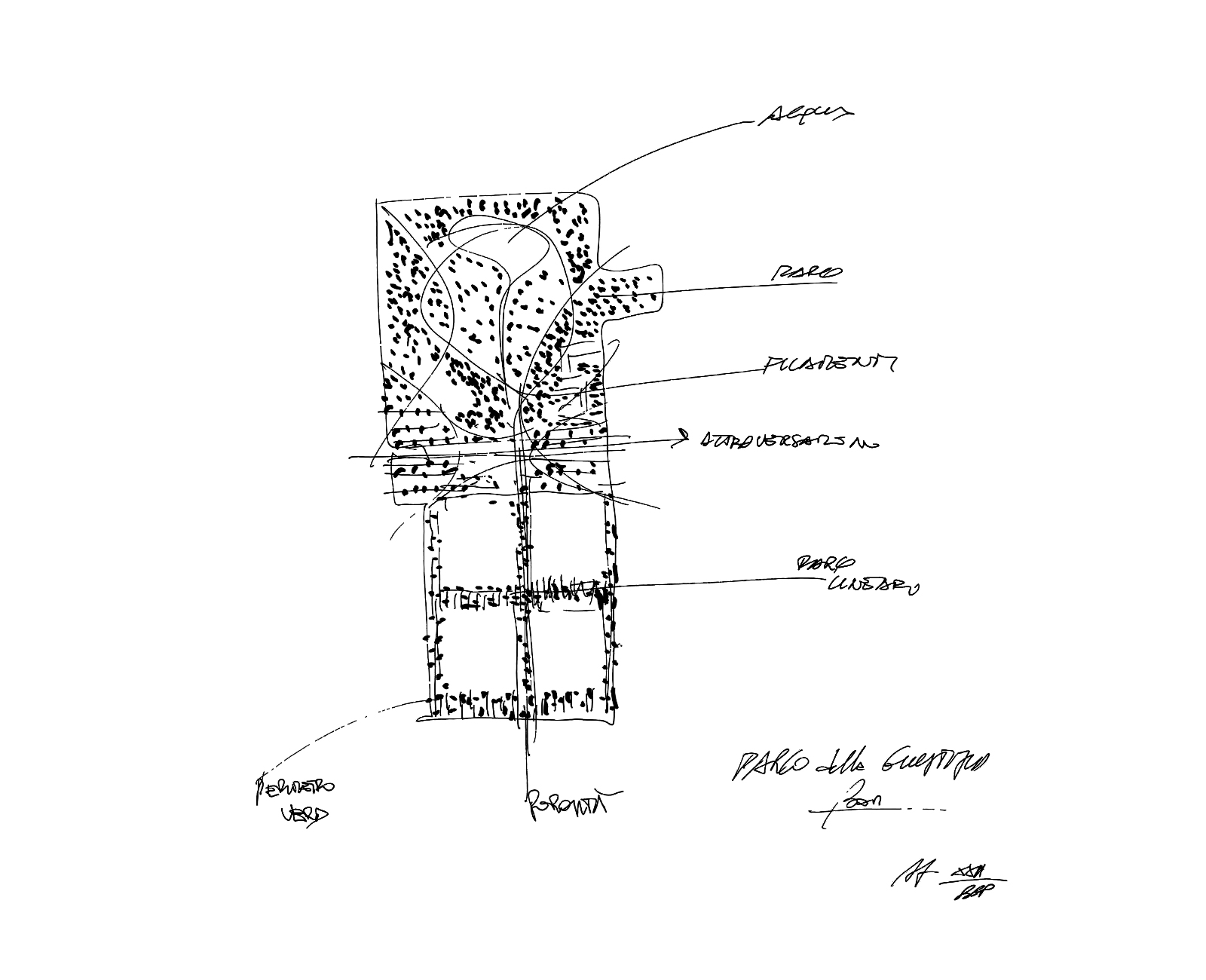
Bari Justice Park
Bari, Italy
2022-ongoing
program: Construction of the new Justice Park of Bari, construction of 4 buildings used for courts, offices and services, a square, roads, and the adjacent park of more than 77,000 square meters with a portion of 7,500 square meters dedicated to an artificial lake intended to create a virtuous water cycle.
Alfonso Femia / Atelier(s) Alfonso Femia with
landscape design: LAND
structural engineering: PROGER S.P.A.
services engineering: MAGNANIMO INGEGNERI ASSOCIATI S.R.L.
images: ©AF517 & Diorama
photos: ©S.Anzini
Bari, Italy
2022-ongoing
program: Construction of the new Justice Park of Bari, construction of 4 buildings used for courts, offices and services, a square, roads, and the adjacent park of more than 77,000 square meters with a portion of 7,500 square meters dedicated to an artificial lake intended to create a virtuous water cycle.
Alfonso Femia / Atelier(s) Alfonso Femia with
landscape design: LAND
structural engineering: PROGER S.P.A.
services engineering: MAGNANIMO INGEGNERI ASSOCIATI S.R.L.
images: ©AF517 & Diorama
photos: ©S.Anzini
“Harmonizing architectural, urban planning and landscape objectives by relating them to the built environment is essential to bring out the territorial intelligence and reattribute value to the overall area.” AF
THE JUSTICE POLE
On a global area of almost 15 hectares, occupied by the 26 buildings that now make up the area of the former disused “Milano” and “Capozzi” Barracks, the Pole will be developed on an area of just over three and a half hectares, or only 30 percent of the entire area, leaving the remaining 70 percent of the area to the park.
By optimizing space and economic resources, the Pole will bring together all of Bari’s judicial offices: the Criminal Court, the Civil Court, the Court of Appeal, the Juvenile Court, the Supervisory Court and the Justice of Peace.
DESIGN, ENVIRONMENTAL SUSTAINABILITY AND SOCIALITY
The interior space of the buildings, where an estimated 1,800 professionals, including judges, prosecutors, magistrates, lawyers and other professionals, will work, will be divided into
a series of judicial courts and training venues, accompanied by administrative and auxiliary environments, connected by generous areas for socializing.
A series of functional and impactful design solutions characterize the “four-leaf clover.”
– “Suspended” central courtyards:
Each courthouse will have an open-air space, where the indoor area merges with the outdoor space in a large courtyard. In three of the four buildings, the court has been placed “suspended” on the first floor in order to provide space for the Criminal and large Assize Courtrooms.
– The entrance agoras:
Large reception halls, conceived as agoras on the ground floor of each building, will welcome external public and those working in the buildings, becoming a living space, of transit but also a place where people can wait, interact and connect.
– The linear plaza and the central north-south axis:
The outdoor space between the buildings creates a central north-south axis that flows into the Linear Square of the Courts, in which the architectural quality of the materials used and the right mix of greenery, trees, and light-colored pavements will ensure the pleasure of stopping and enjoying this urban space. The Linear Square will host native trees and seats for recreational use.
– Working Spaces:
The project is organized to ensure maximum versatility and adaptability of the structure to any new needs, with limited expense and time, thanks to the use of architectural, structural and plant systems that allow for rapid changes in the layout of the rooms through partitions and movable walls.
– Facades:
On the glazed walls of the buildings, there are oblique panels,
the “eyelashes,” arranged with varying inclinations and sizes. They create a game of lights and shadows that never repeats itself, establishing the rhythm of the building, as they vibrate with the light.
– Green roofs:
The roofs are primarily designed to be catalysts for renewable energy, through the large photovoltaic canopies that, along with the green spaces, create an environment in tune with the surrounding landscape.
– Underground and level parking lots:
To meet the need for parking areas in the neighborhood and to serve the new infrastructure, underground parking spaces reserved for construction workers will be built below the buildings. Level parking lots, on the other hand, will be located along the outer road, near the northern lot and along the side adjacent to the Park. Dedicated parking spaces for car sharing services and electric vehicle charging stations are also planned to promote green mobility, including cycling.
– The underground archives:
They are located in the underground level under the perimeter sleeves of each building and receive air and light through the side facades located along the perimeter street of the lot and from a gridded cavity located along the perimeter of each building.
THE PARK
The Justice Park project represents the regeneration of a piece of the city distinguished by a very distinct green identity.
The first action will focus on the creation of the Green Park, consistent with the need to increase urban forestation, to enrich and integrate local biodiversity, and to create a large public space within the city, also the hub and attraction of the neighborhood.
THE GREEN-BLUE RING
The heart of the park is defined by a green-and-blue ring, a path that will enable the visitor to experience different ecosystems and landscape typologies.
Taking advantage of the natural slope, permeable pavements will allow rain to filter directly into the ground, carrying excess water to the northern part of the park, where the pond will collect it.
It will serve as a hydric basin, biodiversity attractor and bioclimatic regulator.
• PROJECT VIDEO:
Bari Justice Park
On a global area of almost 15 hectares, occupied by the 26 buildings that now make up the area of the former disused “Milano” and “Capozzi” Barracks, the Pole will be developed on an area of just over three and a half hectares, or only 30 percent of the entire area, leaving the remaining 70 percent of the area to the park.
By optimizing space and economic resources, the Pole will bring together all of Bari’s judicial offices: the Criminal Court, the Civil Court, the Court of Appeal, the Juvenile Court, the Supervisory Court and the Justice of Peace.
DESIGN, ENVIRONMENTAL SUSTAINABILITY AND SOCIALITY
The interior space of the buildings, where an estimated 1,800 professionals, including judges, prosecutors, magistrates, lawyers and other professionals, will work, will be divided into
a series of judicial courts and training venues, accompanied by administrative and auxiliary environments, connected by generous areas for socializing.
A series of functional and impactful design solutions characterize the “four-leaf clover.”
– “Suspended” central courtyards:
Each courthouse will have an open-air space, where the indoor area merges with the outdoor space in a large courtyard. In three of the four buildings, the court has been placed “suspended” on the first floor in order to provide space for the Criminal and large Assize Courtrooms.
– The entrance agoras:
Large reception halls, conceived as agoras on the ground floor of each building, will welcome external public and those working in the buildings, becoming a living space, of transit but also a place where people can wait, interact and connect.
– The linear plaza and the central north-south axis:
The outdoor space between the buildings creates a central north-south axis that flows into the Linear Square of the Courts, in which the architectural quality of the materials used and the right mix of greenery, trees, and light-colored pavements will ensure the pleasure of stopping and enjoying this urban space. The Linear Square will host native trees and seats for recreational use.
– Working Spaces:
The project is organized to ensure maximum versatility and adaptability of the structure to any new needs, with limited expense and time, thanks to the use of architectural, structural and plant systems that allow for rapid changes in the layout of the rooms through partitions and movable walls.
– Facades:
On the glazed walls of the buildings, there are oblique panels,
the “eyelashes,” arranged with varying inclinations and sizes. They create a game of lights and shadows that never repeats itself, establishing the rhythm of the building, as they vibrate with the light.
– Green roofs:
The roofs are primarily designed to be catalysts for renewable energy, through the large photovoltaic canopies that, along with the green spaces, create an environment in tune with the surrounding landscape.
– Underground and level parking lots:
To meet the need for parking areas in the neighborhood and to serve the new infrastructure, underground parking spaces reserved for construction workers will be built below the buildings. Level parking lots, on the other hand, will be located along the outer road, near the northern lot and along the side adjacent to the Park. Dedicated parking spaces for car sharing services and electric vehicle charging stations are also planned to promote green mobility, including cycling.
– The underground archives:
They are located in the underground level under the perimeter sleeves of each building and receive air and light through the side facades located along the perimeter street of the lot and from a gridded cavity located along the perimeter of each building.
THE PARK
The Justice Park project represents the regeneration of a piece of the city distinguished by a very distinct green identity.
The first action will focus on the creation of the Green Park, consistent with the need to increase urban forestation, to enrich and integrate local biodiversity, and to create a large public space within the city, also the hub and attraction of the neighborhood.
THE GREEN-BLUE RING
The heart of the park is defined by a green-and-blue ring, a path that will enable the visitor to experience different ecosystems and landscape typologies.
Taking advantage of the natural slope, permeable pavements will allow rain to filter directly into the ground, carrying excess water to the northern part of the park, where the pond will collect it.
It will serve as a hydric basin, biodiversity attractor and bioclimatic regulator.
• PROJECT VIDEO:
Bari Justice Park



